The future of wearable health tech: what to expect

The future of wearable health technology involves advancements in real-time health monitoring, personalized health insights, and enhanced communication between patients and healthcare providers, despite challenges such as privacy concerns and usability issues.
The future of wearable health tech holds incredible potential for improving our well-being. Imagine having real-time health data literally at your fingertips. This article dives into the latest advancements and what they mean for you.
Understanding wearable health technology
Wearable health technology is a growing field that combines health monitoring with convenient devices. These innovations offer real-time data and insights, improving our understanding of personal health.
What is wearable health technology?
At its core, wearable health technology includes devices such as smartwatches and fitness trackers. These gadgets monitor various health metrics, from heart rate to sleep patterns. With these devices, users receive instant feedback and can track their health over time.
Key features of wearable health devices
- Data tracking: Measure steps, calories burned, and more.
- Health monitoring: Track heart rate, sleep quality, and stress levels.
- Connectivity: Sync with smartphones for easy access to health data.
- Customization: Set personal health goals and notifications.
These features make wearable devices incredibly useful for those seeking to improve their health. For example, users can set reminders to move or track their hydration levels throughout the day. Wearable technology encourages people to engage in healthier habits by making health management easier.
As the technology advances, we can expect even more sophisticated features. Future wearables might include advanced health diagnostics, providing deeper insights into the user’s health. Imagine a smartwatch that can detect early signs of health issues or monitor chronic conditions seamlessly.
With the benefits come challenges as well. Privacy concerns regarding personal health data can make some individuals hesitant to adopt these technologies. Understanding how data is shared and protected is essential for users.
Key benefits of wearables for personal health
Wearable technology is transforming the way we approach health. The key benefits of wearables for personal health are numerous and impactful. By providing real-time data, these devices empower users to make informed decisions about their well-being.
Real-time health monitoring
One of the primary advantages of wearable health devices is the ability to monitor key health metrics instantly. Users can track their heart rate, sleep quality, and physical activity throughout the day. This constant feedback is invaluable for making adjustments to improve overall health.
Motivation and accountability
Wearables also serve as a constant reminder for individuals to stay active. With notifications and goal-setting capabilities, users stay motivated to reach their fitness targets. It transforms health management into a game where users can challenge themselves or even compete with friends.
- Personalized insights: Wearables provide tailored feedback based on individual activity levels.
- Long-term tracking: Users can monitor progress over weeks or months, gaining insights into their health trends.
- Immediate alerts: Some devices can notify users of irregular heart rates or other potential health issues.
Moreover, the seamless integration with mobile apps allows users to visualize their data, making it easier to understand health patterns. This feature enhances the user experience, leading to better health outcomes. The connection to various health apps can help track nutritional intake and hydration levels, which are essential for a balanced lifestyle.
Wearable health technologies don’t just assist in physical health; they can also help enhance mental well-being. For instance, features like guided breathing exercises and stress monitoring equip users with tools to manage anxiety and stay calm. This holistic view of health is becoming more crucial as our lives get busier.
Latest trends in wearable health devices

The landscape of wearable health devices is rapidly changing, driven by innovation and consumer demand. Keeping up with the latest trends helps users make informed choices about their health technology.
Integration with smart home technology
One of the most exciting trends is the integration of wearables with smart home devices. Users can control their home environment through their wearable devices, enhancing comfort and health. For example, adjusting lighting and temperature based on activity levels or sleep patterns makes personalized health management easier.
Advanced biometric monitoring
Wearable devices are now offering advanced biometric monitoring beyond simple heart rate tracking. Features like electrocardiogram (ECG) readings and blood oxygen saturation monitoring are becoming commonplace. These metrics provide deeper insights into an individual’s health status and allow for early detection of potential issues.
- Stress management: Devices that monitor heart rate variability can help users manage stress more effectively.
- Sleep tracking: Improved algorithms provide better insights into sleep quality and patterns.
- Nutrition tracking: Some wearables now include features to track caloric intake and hydration.
As technology advances, wearable health devices are also becoming more stylish and customizable. Many users prefer devices that match their personal style, leading manufacturers to focus on design without sacrificing functionality. This trend encourages more people to wear these devices consistently.
Another significant trend is the use of artificial intelligence in wearable technology. AI algorithms analyze health data, providing users with personalized recommendations based on their unique patterns. This level of personalization can motivate users to adopt healthier habits and maintain a healthier lifestyle.
How wearables are transforming healthcare
Wearable devices are revolutionizing the healthcare industry by providing continuous, real-time health monitoring. These innovations are making it easier for both patients and healthcare providers to track important health metrics.
Remote patient monitoring
One of the most significant impacts of wearable technology is in remote patient monitoring. Patients can use wearables to send health data directly to their doctors. This allows for timely interventions and adjustments to treatment plans without requiring frequent office visits.
Data-driven decision making
Wearable devices supply healthcare professionals with crucial data. Continuous monitoring helps in spotting health trends early. For instance, doctors can analyze the collected data to make informed decisions about a patient’s health management.
- Timely interventions: Early detection of heart irregularities can prevent severe health complications.
- Reduced hospital visits: Patients can manage chronic diseases from home, which reduces the strain on healthcare facilities.
- Personalized treatment: Data allows doctors to tailor treatments to individual patient needs.
Additionally, wearables encourage patients to take an active role in their health. Features that track daily activity and vital signs boost patient engagement. When patients understand their health data, they are more likely to adhere to treatment and lifestyle modifications.
Moreover, wearables can enhance public health initiatives by providing aggregated data. This information can help health organizations identify trends in specific populations. Understanding these trends allows for better resource allocation and public health planning.
Challenges in adopting wearable health tech
While wearable health tech offers many benefits, there are also significant challenges in adopting these devices. Understanding these hurdles is crucial for both consumers and manufacturers.
Privacy and data security
One of the biggest concerns surrounding wearable health technologies is privacy. Many devices track sensitive health data, and users worry about how this information is stored and shared. Ensuring that data is protected from breaches is essential to gain consumer trust.
Usability and comfort
Another challenge is the usability of the devices. Some wearables may not be comfortable for long-term use, leading to user frustration. For example, bulky designs or complicated interfaces can deter individuals from wearing the devices consistently.
- Device compatibility: Many wearables need to sync with smartphones or apps, which may not always work seamlessly.
- Battery life: Frequent charging can be a hassle, especially for those who want continuous monitoring.
- Learning curve: Some users may struggle to navigate the features of their devices, limiting their effectiveness.
Cost also presents a barrier. High-quality wearable devices can be expensive, and not everyone may be willing to invest in them. This creates a gap in access to health monitoring technology, especially among lower-income individuals.
Moreover, not all wearables provide accurate data. Some devices may have limitations in their sensors or algorithms, which could lead to misleading health information. Users need to be aware of these limitations to avoid making health decisions based on faulty data.
FAQ – Frequently Asked Questions About Wearable Health Technology
What are the main benefits of wearable health technology?
Wearable health technology provides real-time health monitoring, encourages active participation in health management, and enables better communication between patients and healthcare providers.
How does wearable technology improve access to healthcare?
Wearable devices allow for remote patient monitoring, which helps healthcare professionals track patients’ health data without requiring frequent in-person visits.
What are the challenges in using wearables?
Challenges include privacy concerns regarding data security, usability issues with device comfort, cost barriers for many users, and the accuracy of health data collected.
Are wearables suitable for everyone?
While many people can benefit from wearables, factors like personal preferences, budget constraints, and comfort may affect their usability for some individuals.





